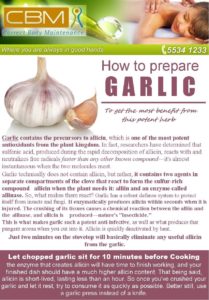How to Prepare Garlic for Eating
How to prepare G A R L I C
To get the most benefit from this potent herb
Garlic contains the precursors to allicin, which is one of the most potent antioxidants from the plant kingdom. In fact, researchers have determined that sulfenic acid, produced during the rapid decomposition of allicin, reacts with and neutralizes free radicals faster than any other known compound—it’s almost instantaneous when the two molecules meet.
Garlic technically does not contain allicin, but rather, it contains two agents in separate compartments of the clove that react to form the sulfur-richcompound allicin when the plant needs it: alliin and an enzyme called allinase. So, what makes them react? Garlic has a robust defense system to protect itself from insects and fungi. It enzymatically produces allicin within seconds when it is injured. The crushing of its tissues causes a chemical reaction between the alliin and the allinase, and allicin is produced—nature’s “insecticide.”
This is what makes garlic such a potent anti-infective, as well as what produces that pungent aroma when you cut into it. Allicin is quickly deactivated by heat.
Just two minutes on the stove top will basically eliminate any useful allicin from the garlic.
Let chopped garlic sit for 10 minutes before Cooking the enzyme that creates allicin will have time to finish working, and your finished dish should have a much higher allicin content. That being said, allicin is short-lived, lasting less than an hour. So once you’ve crushed your garlic and let it rest, try to consume it as quickly as possible. Better still, use a garlic press instead of a knife.
“Using a garlic press is even better than mincing, as it releases more of the compounds that combine to create allicin.”



